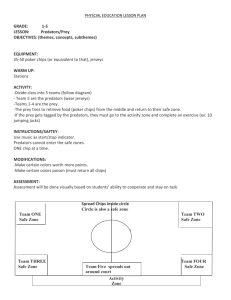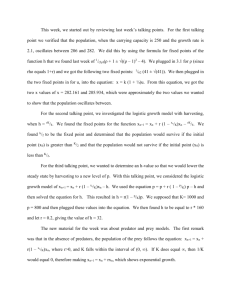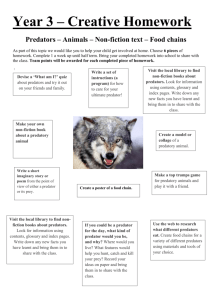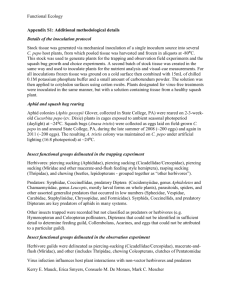Ecology 203, Exam I
advertisement
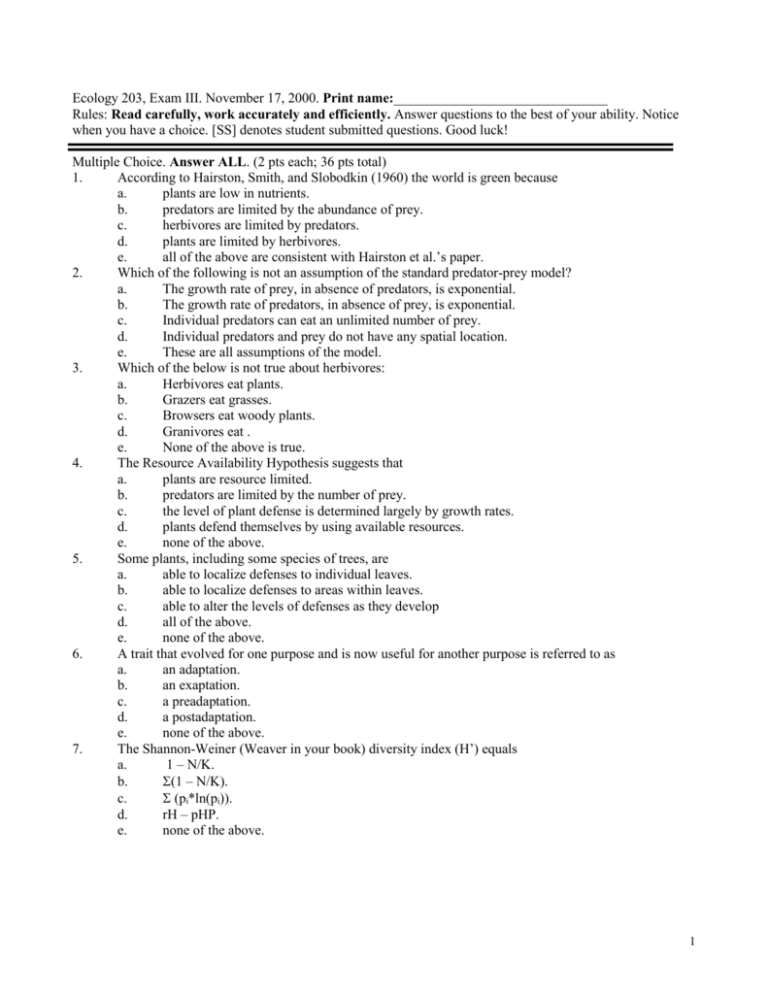
Ecology 203, Exam III. November 17, 2000. Print name:_______________________________ Rules: Read carefully, work accurately and efficiently. Answer questions to the best of your ability. Notice when you have a choice. [SS] denotes student submitted questions. Good luck! Multiple Choice. Answer ALL. (2 pts each; 36 pts total) 1. According to Hairston, Smith, and Slobodkin (1960) the world is green because a. plants are low in nutrients. b. predators are limited by the abundance of prey. c. herbivores are limited by predators. d. plants are limited by herbivores. e. all of the above are consistent with Hairston et al.’s paper. 2. Which of the following is not an assumption of the standard predator-prey model? a. The growth rate of prey, in absence of predators, is exponential. b. The growth rate of predators, in absence of prey, is exponential. c. Individual predators can eat an unlimited number of prey. d. Individual predators and prey do not have any spatial location. e. These are all assumptions of the model. 3. Which of the below is not true about herbivores: a. Herbivores eat plants. b. Grazers eat grasses. c. Browsers eat woody plants. d. Granivores eat . e. None of the above is true. 4. The Resource Availability Hypothesis suggests that a. plants are resource limited. b. predators are limited by the number of prey. c. the level of plant defense is determined largely by growth rates. d. plants defend themselves by using available resources. e. none of the above. 5. Some plants, including some species of trees, are a. able to localize defenses to individual leaves. b. able to localize defenses to areas within leaves. c. able to alter the levels of defenses as they develop d. all of the above. e. none of the above. 6. A trait that evolved for one purpose and is now useful for another purpose is referred to as a. an adaptation. b. an exaptation. c. a preadaptation. d. a postadaptation. e. none of the above. 7. The Shannon-Weiner (Weaver in your book) diversity index (H’) equals a. 1 – N/K. b. (1 – N/K). c. (pi*ln(pi)). d. rH – pHP. e. none of the above. 1 8. 9. 10. 11. 12. 13. It has been suggested that the world is green. Why is this? [SS] a. Plants are poor in nitrogen which can hinder animals from eating them. b. Plants have too much nitrogen which can prohibit animals from eating them. c. Plants have two types of defenses, constituent and induced, which limits some animals from consuming them. c. Both A and C e. Both B and C After studying different species of plants' responses to various situations and conditions, it can be concluded that plant performance directly depends on: [SS] a. The resources that are available to the plants b. The presence of enemies (herbivores) c. The presence of predators of the herbivores d. Answers A and B e. All of the above The response to competition differs from the measure of asymmetry because it a. does not account for the true differences between competitors b. measures only the mass of individuals rather than fecundity c. may show negative effects for one species due to competition when, in fact, a species may be hurt by competition. d. all of the above are differences between these measures of competition. e. none of the above. The graph to the right suggests that plant biomass increases with soil nitrogen when a. plants are grown at low densities. b. plants are grown at high densities. c. plants are subject to herbivory. d. given intense UV radiation. e. ever. The study investigating the effect of large granivorous rodents on other rodent populations, done in the desert southwest by Jim Brown and others, suggested that a. small granivores compete with large granivores. b. small granivores do not compete with large granivores. c. small insectivores compete with small granivores. d. all of the above. e. none of the above. Character displacement, such as was seen for beak depths of finches on the Galapagos, may be explained by which of the following mechanisms. a. competition in the past (the so-called “ghost of competition past”). b. previous extinctions that have left the species we now see as having different beak depths. c. the evolution of beak depths that were previous more different than present changing to be more similar. d. all of the above. e. none of the above. 2 14. 15. 16. 17. 18. Prey may avoid predation through a. being too big to consume. b. being too small to consume. c. defending themselves in groups. d. the benefits of spatial heterogeneity. e. all of the above. Your field guide suggested that monarch caterpillars consume milkweed, which contains high levels of a cardiac glycoside, a. to defend itself from competitors. b. to defend itself from predators. c. to eat a food that is actually rich in nitrogen d. to produce the red warning coloration of the monarch butterfly. e. to survive - it’s really just an exaptation. Your textbook suggests that niche differentiation among species results in a. species coexistence. b. competitive exclusion. c. increased resource abundance. d. all of the above. e. none of the above. The diversity movie we saw suggested the following new mechanism for maintaining high plant diversity in the tropics: high diversity is a. achieved by way of the intermediate disturbance hypothesis. b. achieved through high levels of herbivory. c. the result of warm annual temperatures and a lot of rainfall. d. due to all of the above. e. due to none of the above. The Theory of Island Biogeography has the following two assumptions (circle two): a. species richness increases as a function of area. b. islands have similar habitats as the mainland. c. islands exhibit habitat stochasticity. d. fewer individuals are likely to get to islands further away than close islands. e. islands in the ocean and fragments like forests in agricultural areas both function as islands. True/False. Answer ALL. (2 pts each; 10 pts total) 1. T F Constituent defenses generally are expressed before induced defenses. 2. T F Plants are able to localize induced defenses. 3. T F Mutualisms are always beneficial for both participants (either individuals or species). 4. T F Species richness is inversely related to both latitude and altitude. 5. T F Hartvigsen’s study of plants, herbivores, and predators in 1995 suggested that plants, without herbivores or predators, perform best (in terms of leaf area) when fertilized. 3 Short-answer questions. Answer ONE. (4 pts total) 1. Fill in the table below and describe any patterns that might not so easily be explained by a “-,” “+,” or “0.” Species 1 Species 2 Competition Predation Herbivory Host-pathogen Commensalism Amensalism 2. Provide a single equation from the predator-prey or competition coupled differential equation models. The equation should be complete for one species. Please identify the equilibrium solution(s) analytically for your equation. No graph should be provided. Graphing questions. ANALYZE ALL GRAPHS COMPLETELY! Word descriptions should be completely avoided unless specifically requested. Answer 5 of 9. (10 pts each; 50 pts total) 1. Graph the standard Lotka-Volterra predator-prey model below. First, identify the lines. Second, assess the predator-prey dynamics over time. Create a coupled graph of N vs. t in the space to the right. 4 2. Create a phase-plane graph for two competitors that are able to coexist in a stable equilibrium. Draw another graph of N vs. time, starting from an interesting spot on the graph (your choice). 3. Graph the herbivore optimization hypothesis below and provide an example (briefly describe the example with words). 5 4. Draw a gastrointestinal track that you have seen in lecture (also seen in book) that would be adapted to processing woody plants. Briefly explain your conclusion. 5. Briefly explain the result of the graph below. 6 6. Briefly explain the significance of the graph. Write neatly. Draw arrows to graph if necessary for clarification 7. Create a graph that depicts the evolution of pathogen toward benign coexistence with its host. Briefly discuss using an additional graph why this is or isn’t expected. 7 8. Create a graph of two species whose fundamental niches overlap but their realized niches do not overlap for two critical resources. 9. Graph the intermediate disturbance hypothesis. Label the axes of your graph clearly. 8




